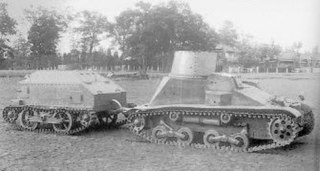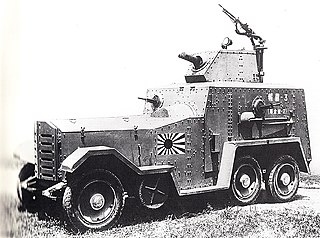
The Type 94 tankette was a tankette used by the Imperial Japanese Army in the Second Sino-Japanese War, at Nomonhan against the Soviet Union, and in World War II. Although tankettes were often used as ammunition tractors, and general infantry support, they were designed for reconnaissance, and not for direct combat. The lightweight Type 94 proved effective in China as the Chinese National Revolutionary Army had only three tank battalions to oppose them, and those tank battalions were equipped only with some British export models and Italian CV-33 tankettes. As with nearly all tankettes built in the 1920s and 1930s, they had thin armor that could be penetrated by .50 caliber (12.7 mm) machine gun fire at 600 yards (550 m) range.

The Type 97 Light armored car Te-Ke was a tankette used by the Imperial Japanese Army in the Second Sino-Japanese War, at Nomonhan against the Soviet Union, and in World War II. It was designed as a fast reconnaissance vehicle, and was a replacement for the earlier Type 94 tankette.

The Type 97 Chi-Ha was a medium tank used by the Imperial Japanese Army during the Second Sino-Japanese War, the Battles of Khalkhin Gol against the Soviet Union, and the Second World War. It was the most widely produced Japanese medium tank of World War II.

The Type 1 Ho-Ha was a half-track armoured personnel carrier (APC) used in limited numbers by the Imperial Japanese Army (IJA) during World War II.

The Type 94 disinfecting vehicle and Type 94 gas scattering vehicle were variants of the Type 94 tankette adapted to chemical warfare by the Imperial Japanese Army. The Type 94 disinfecting vehicle and Type 94 gas scattering vehicle were configured as either an independent mobile liquid dissemination chemical vehicle or a respective mobile disinfecting anti-chemical agents vehicle to support the Japanese chemical infantry units in combat.

The Type 95 Ha-Gō was a light tank used by the Empire of Japan during the Second Sino-Japanese War, at Nomonhan against the Soviet Union, and in the Second World War. It proved sufficient against infantry but was not effective against other tanks. Approximately 2,300 were produced, making it the most numerous Japanese armoured fighting vehicle of the Second World War.

The Type 92 heavy armoured car, also known as the Type 92 cavalry tank, was the Empire of Japan's first indigenous tankette. Designed for use by the cavalry of the Imperial Japanese Army by Ishikawajima Motorcar Manufacturing Company, the Type 92 was designed for scouting and infantry support. The Type 92 was thin armored and lightly armed. Although actually a light tank, it was called sōkōsha in Japanese due to political sectionalism within the Japanese Army. Exactly the same device was used in America with the M1 Combat Car.

The Type 1 Ho-Ki was a tracked armored personnel carrier (APC) developed by the Imperial Japanese Army in World War II.

The Imperial Japanese Army (IJA) initially purchased foreign tanks for evaluation during World War I, and began developing its own indigenous designs during the late 1920s.

The Type 2 Ke-To was a light tank of World War II, produced in small numbers for the Imperial Japanese Army as an improvement of the existing Type 98 Ke-Ni. No Type 2 Ke-To light tanks are known to have engaged in combat prior to Japan's surrender at the end of World War II.

The Type 89 medium tank I-Go is a medium tank used by the Imperial Japanese Army from 1932 to 1942 in combat operations of the Second Sino-Japanese War, at Khalkhin Gol against the Soviet Union, and in the Second World War. The Type 89B model was the world's first mass-produced diesel engine tank. The tank was armed with a short-barrel 57 mm cannon for knocking out pillboxes and masonry fortifications, and proved effective in campaigns in Manchuria and China, as the Chinese National Revolutionary Army had only three tank battalions to oppose them, which consisted primarily of Vickers export models, German Panzer Is, and Italian CV33 tankettes. The Type 89 was a 1920s design medium tank, built to support the infantry, and thus lacked the armor or armament of 1940s generation Allied armor; it was regarded as obsolete by the time of the 1939 battles of Khalkhin Gol, against the Soviet Union. The code designation "I-Go" comes from the katakana letter [イ] for "first" and the kanji [号] for "number". The designation is also transliterated Chi-Ro and sometimes "Yi-Go".

The Type 5 medium tank Chi-Ri was a medium tank developed by the Imperial Japanese Army in World War II. It was intended to be a heavier, more powerful version of Japan's prototype Type 4 Chi-To medium tank. Only one incomplete prototype was built.

This article deals with the history and development of tanks of the Japanese Army from their first use after World War I, into the interwar period, during World War II, the Cold War and modern era.

The Type 93 armoured car (九三式装甲自動車) was an armoured car used by the Empire of Japan both before and during World War II in China.

The Sumida M.2593 was an armoured car produced by the Empire of Japan in the 1930s. It could operate on both the roadway and railway lines. There were two main versions of the Sumida M.2593 made. The Type 91 armoured railroad car was used by the army and the Sumida Model P armored car was used by the Special Naval Landing Forces (SNLF) of the navy.

The Chiyoda armoured car was the first domestic Japanese armoured car which was officially introduced by the Imperial Japanese Army (IJA) and produced in the 1930s.

















